warning KIA SOUL 2018 Features and Functions Guide
[x] Cancel search | Manufacturer: KIA, Model Year: 2018, Model line: SOUL, Model: KIA SOUL 2018Pages: 50, PDF Size: 4.97 MB
Page 2 of 50

GETTING TO KNOW YOUR SOUL
Congratulations on Your New Kia Purchase!
Your new Kia vehicle has been designed, engineered and manufactured to provide you with years of comfortable and dependable
driving. Kia is committed to quality, innovation, safety and — above all — your satisfaction.
Using This Guide
The information contained in this guide is a brief overview that will help you become familiar with the operation and features of your new Kia vehicle. The flipbook format facilitates information access, while the detailed illustrations help to ensure the instructions are easy to follow.
This Features & Functions Guide, and the specific operational and safety information it provides, is not a substitute for your Owner’s Manual. In the interest of your safety and that of your family, and to help you avoid risks that may result in death or serious injury, Kia reminds you to carefully read your Owner’s Manual in order to fully familiarize yourself with the important information it contains.
While the information contained in this guide is accurate at the time of printing, Kia may change vehicle specifications without notice in advance or after the fact, and assumes no liability in connection with such changes.
www.kia.com
Consumer - Roadside Assistance 1-800-333-4KIA (4542)
See Back Pages for Vehicle Maintenance Schedule Always check the Owner’s Manual for complete operating information and safety warnings.
Page 3 of 50
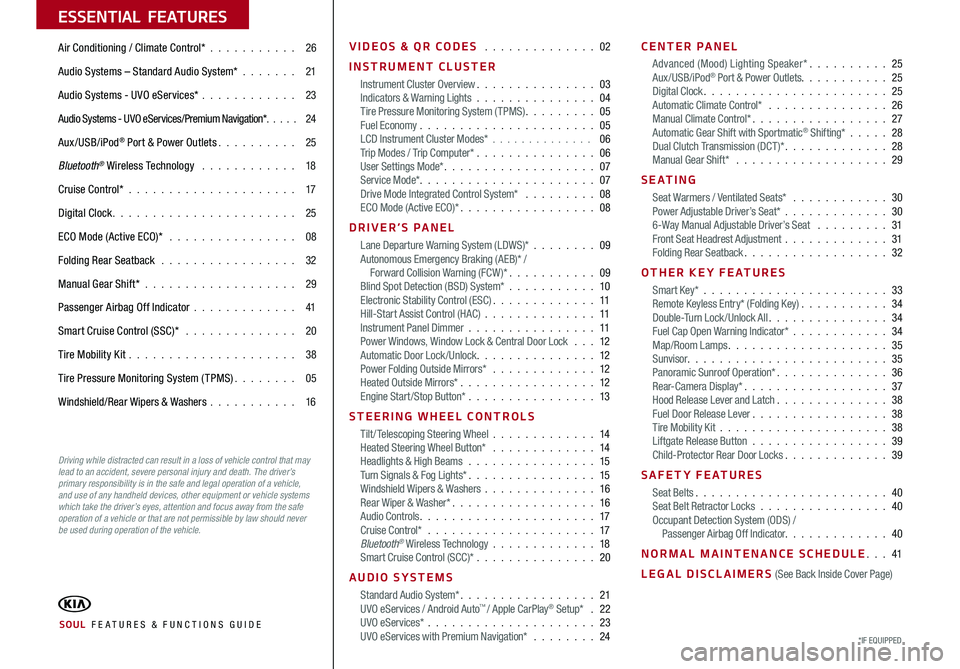
ESSENTIAL FEATURES
Air Conditioning / Climate Control* 26
Audio Systems – Standard Audio System* 21
Audio Systems - UVO eServices* 23
Audio Systems - UVO eServices/Premium Navigation* 24
Aux/USB/iPod® Port & Power Outlets 25
Bluetooth® Wireless Technology 18
Cruise Control* 17
Digital Clock 25
ECO Mode (Active ECO)* 08
Folding Rear Seatback 32
Manual Gear Shift* 29
Passenger Airbag Off Indicator 41
Smart Cruise Control (SSC)* 20
Tire Mobility Kit 38
Tire Pressure Monitoring System (TPMS) 05
Windshield/Rear Wipers & Washers 16
VIDEOS & QR CODES 02
INSTRUMENT CLUSTER
Instrument Cluster Overview 03Indicators & Warning Lights 04Tire Pressure Monitoring System (TPMS) 05Fuel Economy 05LCD Instrument Cluster Modes* 06Trip Modes / Trip Computer* 06User Settings Mode* 07Service Mode* 07Drive Mode Integrated Control System* 08ECO Mode (Active ECO)* 08
DRIVER’S PANEL
Lane Departure Warning System (LDWS)* 09Autonomous Emergency Braking (AEB)* / Forward Collision Warning (FCW )* 09Blind Spot Detection (BSD) System* 10Electronic Stability Control (ESC) 11Hill-Start Assist Control (HAC) 11Instrument Panel Dimmer 11Power Windows, Window Lock & Central Door Lock 12Automatic Door Lock /Unlock 12Power Folding Outside Mirrors* 12Heated Outside Mirrors* 12Engine Start/Stop Button* 13
STEERING WHEEL CONTROLS
Tilt/ Telescoping Steering Wheel 14Heated Steering Wheel Button* 14Headlights & High Beams 15Turn Signals & Fog Lights* 15Windshield Wipers & Washers 16Rear Wiper & Washer* 16Audio Controls 17Cruise Control* 17Bluetooth® Wireless Technology 18Smart Cruise Control (SCC)* 20
AUDIO SYSTEMS
Standard Audio System* 21UVO eServices / Android Auto™ / Apple CarPlay® Setup* 22UVO eServices* 23 UVO eServices with Premium Navigation* 24
CENTER PANEL
Advanced (Mood) Lighting Speaker* 25Aux/USB/iPod® Port & Power Outlets 25Digital Clock 25Automatic Climate Control* 26Manual Climate Control* 27Automatic Gear Shift with Sportmatic® Shifting* 28Dual Clutch Transmission (DCT )* 28Manual Gear Shift* 29
S E AT I N G
Seat Warmers / Ventilated Seats* 30Power Adjustable Driver’s Seat* 306-Way Manual Adjustable Driver’s Seat 31Front Seat Headrest Adjustment 31Folding Rear Seatback 32
OTHER KEY FEATURES
Smart Key* 33Remote Keyless Entry* (Folding Key) 34Double-Turn Lock /Unlock All 34Fuel Cap Open Warning Indicator* 34Map/Room Lamps 35Sunvisor 35Panoramic Sunroof Operation* 36Rear-Camera Display* 37Hood Release Lever and Latch 38Fuel Door Release Lever 38Tire Mobility Kit 38Liftgate Release Button 39Child-Protector Rear Door Locks 39
SAFETY FEATURES
Seat Belts 40Seat Belt Retractor Locks 40Occupant Detection System (ODS) / Passenger Airbag Off Indicator 40
NORMAL MAINTENANCE SCHEDULE 41
LEGAL DISCLAIMERS (See Back Inside Cover Page)
*IF EQUIPPED SOUL FE ATURES & FUNCTIONS GUIDE
Driving while distracted can result in a loss of vehicle control that may lead to an accident, severe personal injury and death. The driver’s primary responsibility is in the safe and legal operation of a vehicle, and use of any handheld devices, other equipment or vehicle systems which take the driver’s eyes, attention and focus away from the safe operation of a vehicle or that are not permissible by law should never be used during operation of the vehicle.
Page 5 of 50
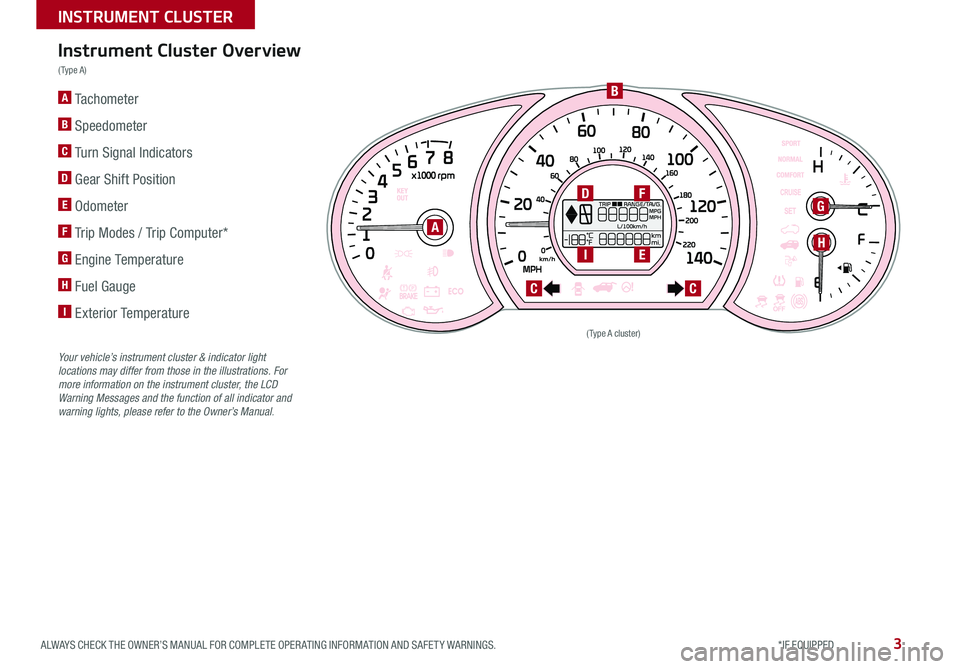
3ALWAYS CHECK THE OWNER’S MANUAL FOR COMPLETE OPER ATING INFORMATION AND SAFET Y WARNINGS *IF EQUIPPED
INSTRUMENT CLUSTER
A Tachometer
B Speedometer
C Turn Signal Indicators
D Gear Shift Position
E Odometer
F Trip Modes / Trip Computer*
G Engine Temperature
H Fuel Gauge
I Exterior Temperature
Instrument Cluster Overview
( Type A )
Your vehicle’s instrument cluster & indicator light locations may differ from those in the illustrations. For more information on the instrument cluster, the LCD Warning Messages and the function of all indicator and warning lights, please refer to the Owner’s Manual.
(Type A cluster)
A
B
D
I
CC
G
HE
F
Page 6 of 50
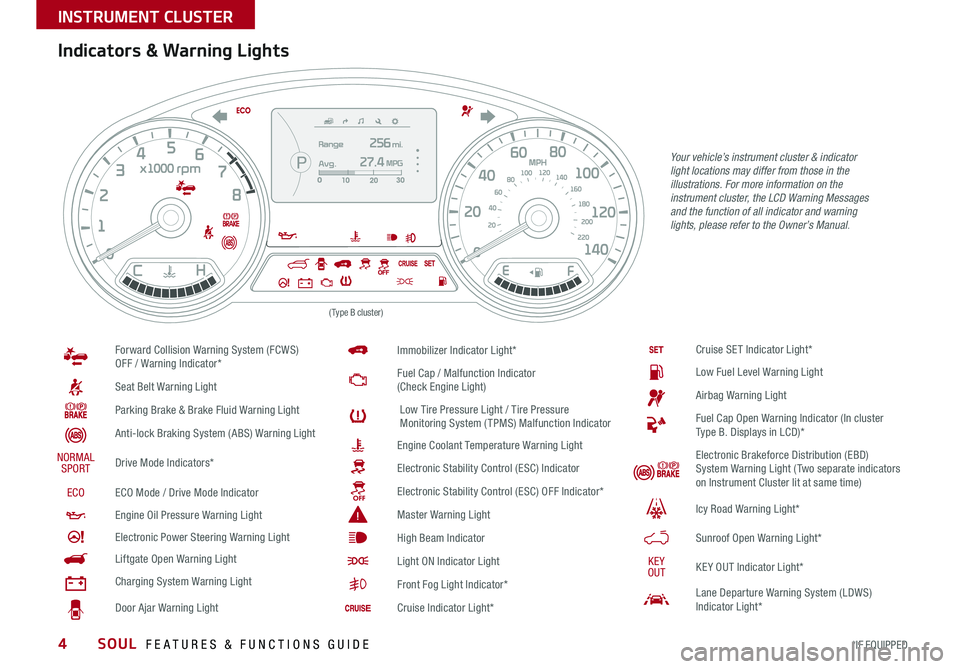
SOUL FEATURES & FUNCTIONS GUIDE4*IF EQUIPPED
INSTRUMENT CLUSTER
Indicators & Warning Lights
(Type B cluster)
Forward Collision Warning System (FCWS) OFF / Warning Indicator*
Seat Belt Warning Light
Parking Brake & Brake Fluid Warning Light
Anti-lock Braking System (ABS) Warning Light
NORMALSPORTDrive Mode Indicators*
ECOECO Mode / Drive Mode Indicator
Engine Oil Pressure Warning Light
Electronic Power Steering Warning Light
Liftgate Open Warning Light
Charging System Warning Light
Door Ajar Warning Light
Immobilizer Indicator Light*
Fuel Cap / Malfunction Indicator (Check Engine Light)
Low Tire Pressure Light / Tire Pressure Monitoring System (TPMS) Malfunction Indicator
Engine Coolant Temperature Warning Light
Electronic Stability Control (ESC) Indicator
Electronic Stability Control (ESC) OFF Indicator*
Master Warning Light
High Beam Indicator
Light ON Indicator Light
Front Fog Light Indicator*
Cruise Indicator Light*
Cruise SET Indicator Light*
Low Fuel Level Warning Light
Airbag Warning Light
Fuel Cap Open Warning Indicator (In cluster Type B Displays in LCD)*
Electronic Brakeforce Distribution (EBD) System Warning Light ( Two separate indicators on Instrument Cluster lit at same time)
Icy Road Warning Light*
Sunroof Open Warning Light*
KEYOUTKE Y OUT Indicator Light*
Lane Departure Warning System (LDWS) Indicator Light*
Your vehicle’s instrument cluster & indicator light locations may differ from those in the illustrations. For more information on the instrument cluster, the LCD Warning Messages and the function of all indicator and warning lights, please refer to the Owner’s Manual.
Page 7 of 50
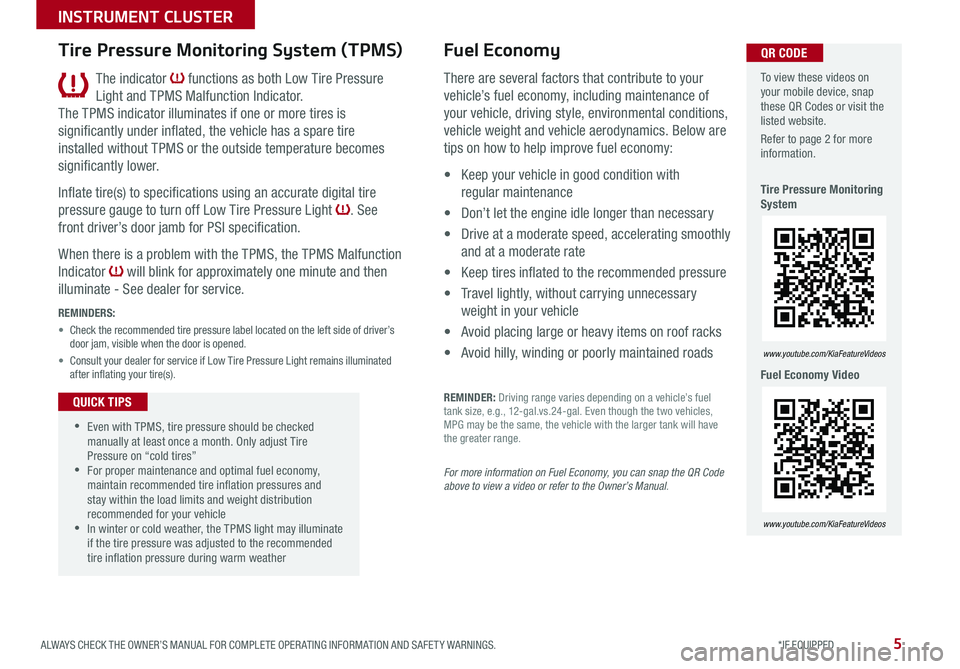
5ALWAYS CHECK THE OWNER’S MANUAL FOR COMPLETE OPER ATING INFORMATION AND SAFET Y WARNINGS *IF EQUIPPED
INSTRUMENT CLUSTER
The indicator functions as both Low Tire Pressure
Light and TPMS Malfunction Indicator
The TPMS indicator illuminates if one or more tires is
significantly under inflated, the vehicle has a spare tire
installed without TPMS or the outside temperature becomes
significantly lower
Inflate tire(s) to specifications using an accurate digital tire
pressure gauge to turn off Low Tire Pressure Light See
front driver’s door jamb for PSI specification
When there is a problem with the TPMS, the TPMS Malfunction
Indicator will blink for approximately one minute and then
illuminate - See dealer for service
REMINDERS:
• Check the recommended tire pressure label located on the left side of driver’s door jam, visible when the door is opened
• Consult your dealer for service if Low Tire Pressure Light remains illuminated after inflating your tire(s)
Tire Pressure Monitoring System (TPMS)
•Even with TPMS, tire pressure should be checked manually at least once a month Only adjust Tire Pressure on “cold tires” •For proper maintenance and optimal fuel economy, maintain recommended tire inflation pressures and stay within the load limits and weight distribution recommended for your vehicle •In winter or cold weather, the TPMS light may illuminate if the tire pressure was adjusted to the recommended tire inflation pressure during warm weather
QUICK TIPS
Fuel Economy
There are several factors that contribute to your
vehicle’s fuel economy, including maintenance of
your vehicle, driving style, environmental conditions,
vehicle weight and vehicle aerodynamics Below are
tips on how to help improve fuel economy:
• Keep your vehicle in good condition with
regular maintenance
• Don’t let the engine idle longer than necessary
• Drive at a moderate speed, accelerating smoothly
and at a moderate rate
• Keep tires inflated to the recommended pressure
• Travel lightly, without carrying unnecessary
weight in your vehicle
• Avoid placing large or heavy items on roof racks
• Avoid hilly, winding or poorly maintained roads
REMINDER: Driving range varies depending on a vehicle’s fuel tank size, e g , 12-gal vs 24-gal Even though the two vehicles, MPG may be the same, the vehicle with the larger tank will have the greater range
For more information on Fuel Economy, you can snap the QR Code above to view a video or refer to the Owner’s Manual.
To view these videos on your mobile device, snap these QR Codes or visit the listed website
Refer to page 2 for more information
Tire Pressure Monitoring System
Fuel Economy Video
www.youtube.com/KiaFeatureVideos
www.youtube.com/KiaFeatureVideos
QR CODE
Page 8 of 50
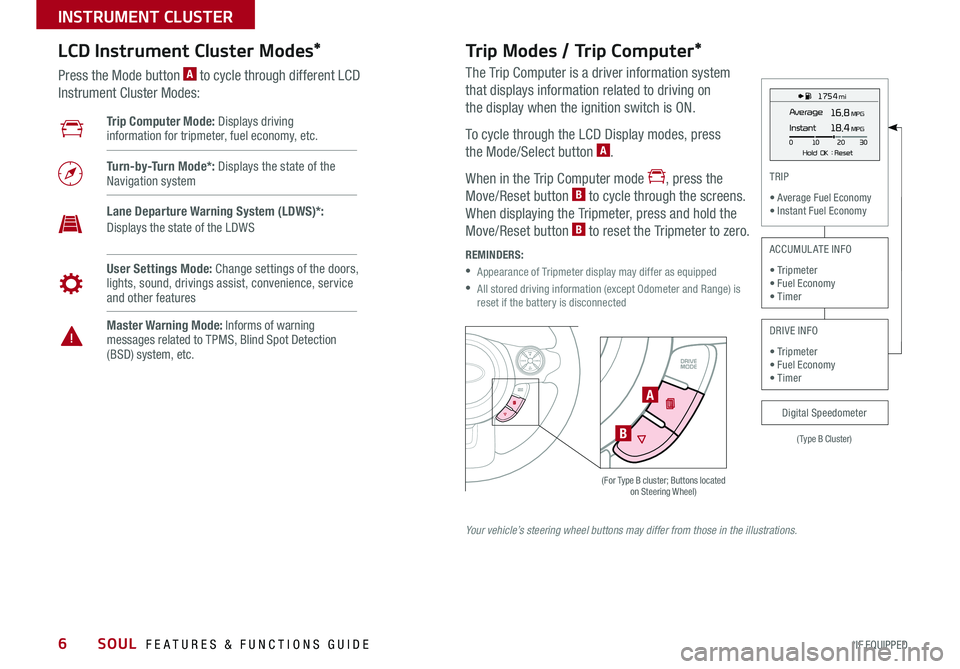
SOUL FEATURES & FUNCTIONS GUIDE6*IF EQUIPPED
INSTRUMENT CLUSTER
The Trip Computer is a driver information system
that displays information related to driving on
the display when the ignition switch is ON
To cycle through the LCD Display modes, press
the Mode/Select button A
When in the Trip Computer mode , press the
Move/Reset button B to cycle through the screens
When displaying the Tripmeter, press and hold the
Move/Reset button B to reset the Tripmeter to zero
REMINDERS:
•
Appearance of Tripmeter display may differ as equipped
•
All stored driving information (except Odometer and Range) is reset if the battery is disconnectedSET
CRUISE
RES
CANCELMODE
VOL
VOL
SETCRUISERESCANCELMODEVOL
VOL
(For Type B cluster; Buttons located on Steering Wheel)
1 75 4 mi
16.8 MPGAverage
0 10
Hold OK : Reset20
30
Instant18.4 MPG
(Type B Cluster)
TRIP
• Average Fuel Economy• Instant Fuel Economy
Digital Speedometer
ACCUMULATE INFO
• Tripmeter• Fuel Economy• Timer
DRIVE INFO
• Tripmeter • Fuel Economy • Timer
Trip Computer Mode: Displays driving information for tripmeter, fuel economy, etc
Turn-by-Turn Mode*: Displays the state of the Navigation system
User Settings Mode: Change settings of the doors, lights, sound, drivings assist, convenience, service and other features
Master Warning Mode: Informs of warning messages related to TPMS, Blind Spot Detection (BSD) system, etc
Lane Departure Warning System (LDWS)*: Displays the state of the LDWS
LCD Instrument Cluster Modes*
Press the Mode button A to cycle through different LCD
Instrument Cluster Modes:
Trip Modes / Trip Computer*
Your vehicle’s steering wheel buttons may differ from those in the illustrations.
A
B
Page 9 of 50

7ALWAYS CHECK THE OWNER’S MANUAL FOR COMPLETE OPER ATING INFORMATION AND SAFET Y WARNINGS *IF EQUIPPED
INSTRUMENT CLUSTER
To enter Service Mode, press the Mode/Select button A
and select User Settings , then scroll to Service Mode
by pressing Move/Reset button B Press the Mode/Select
button A to enter System will display number of miles
remaining until next service is due, and type of service
When service is required, the following will be displayed:
Service Required
To reset the Service Mode system, press and hold the
Move/Reset button B for more than 1 second
To turn Service In OFF, go to User Settings
Service Interval Setting
To set the service interval when in User Settings mode:
•Press the Move/Reset button B and scroll to Service Interval
Press the Mode/Select button A to enter
•Press the Move/Reset button B and toggle to ON, then press
the Move/Select button A
Then press the Move/Reset
button B to scroll and select
the desired miles or months for
your next service
•Press the Mode/Select button A to enter
SET
CRUISE
RES
CANCELMODE
VOL
VOL
User Settings Mode*Service Mode*
18,000mi365days
18,000mi365days
18,000mi365days
To enter the User Settings mode in the LCD Instrument
Cluster Modes, press the Mode/Select button A when the
vehicle is at a standstill and with the Engine Start /Stop*
button in the ON position and select User Settings
You can navigate the selections on the display by pressing
the Move/Reset button B, and then selecting the item by
pressing the Mode/Select button A
Driving Assist*:
•Rear Cross Traffic Alert*
•FCW (Forward Collision Warning)*
•BSD (Blind Spot Detection)*
Door/Liftgate:
•Auto Door Lock
•Auto Door Unlock
•Two Press Unlock
•Horn Feedback
Lights:
•One-Touch Turn Signal*
•Headlamp Delay*
Sound:
•Park Assist System Volume*
•Welcome Sound*
Service Interval:
•Set mileage/months
•ON/OFF
Convenience:
•Gear Position Pop-Up*
Other Features:
•Fuel Economy Auto Reset
•Fuel Economy Unit
•Temperature Unit
Language:
•Language Setting
A
B
(For Type B cluster; Buttons located on Steering Wheel)
(Instrument cluster LCD screen shown)
To view these videos on your mobile device, snap these QR Codes or visit the listed website
Refer to page 2 for more information
LCD Display Video
LCD Display: Maintenance Video
www.youtube.com/KiaFeatureVideos
www.youtube.com/KiaFeatureVideos
QR CODE
Page 11 of 50

9ALWAYS CHECK THE OWNER’S MANUAL FOR COMPLETE OPER ATING INFORMATION AND SAFET Y WARNINGS *IF EQUIPPED
DRIVER'S PANEL
Autonomous Emergency Braking (AEB) / Forward Collision Warning (FCW)*
The AEB and FCWS help to alert the driver when rapidly approaching a
vehicle that is slowing down, braking or stopped A warning message will
appear on the LCD screen and a chime will sound
The FCWS will become active when the vehicle is traveling more than
10 mph The AEB will become active when the vehicle is traveling more
than 6 mph
Select alert settings (Early, Normal, Late) in the User Settings in the
instrument cluster LCD display To turn the AEB/FCWS off, go to User
Settings in the LCD Instrument Cluster modes
The Autonomous Emergency Braking (AEB) / Forward Collision Warning (FCW)* are not substitutes for safe and proper driving. Always drive safely and use caution. The FCWS will be activated by default when the ignition is cycled ON, even when previous setting to OFF.
Lane Departure Warning System (LDWS)*
With the Engine Start /Stop button in the ON position, press the LDWS button A
(shown on previous page) to turn system ON The instrument cluster indicator
will illuminate white
If the LDWS detects that you are veering outside of your lane, the system may issue
a warning on the LCD screen and an alert may sound, under these conditions:
•The vehicle exceeds approximately 40 mph
•The LDWS system recognizes the lane the vehicle is traveling in
If LDWS button is ON/OFF and ignition is cycled, the system returns to
its previous state
REMINDER: LDWS will not issue a warning if the turn signal or hazard lights are activated
REMINDERS:
• The FCWS and AEB will be activated by default when vehicle power is cycled on, even when previous setting is off
• The FCWS will not operate when the vehicle is traveling more than approximately 50 mph
The Lane Departure Warning System (LDWS) is not a substitute for safe and proper driving. Always drive safely and use caution. LDWS may not always alert the driver if the vehicle is driven outside of its lane.
When the LDWS sensor detects the lane traveling in, the lane is illuminatedWhen the LDWS sensor does not detect the lane traveling in the lanes is not illuminatedWhen the LDWS sensor detects the vehicle veering outside of the lane traveling in, the lane the vehicle’s crossing will blink (shown in both images above)Lane DepartureLane Departure
Lane DepartureLane DepartureLane DepartureLane Departure
Lane DepartureLane Departure
Lane DepartureLane Departure
Lane DepartureLane DepartureLane DepartureLane Departure
Lane DepartureLane Departure
A
Lane Departure Warning System Video
To view a video on your mobile device, snap this QR Code or visit the listed website
Refer to page 2 for more information
www youtube com/KiaFeatureVideos
QR CODE
Page 12 of 50

SOUL FEATURES & FUNCTIONS GUIDE10*IF EQUIPPED
DRIVER'S PANEL
Blind Spot Detection (BSD) System*
Blind Spot Detection w/ RCTA Video
To view a video on your mobile device, snap this QR Code or visit the listed website
Refer to page 2 for more information
www youtube com/KiaFeatureVideos
QR CODE
For more information on the BSD System, refer to your Owner’s Manual.
The above images are for illustration purposes only and may not reflect actual operation.
The BSD system uses radar sensors to help alert the driver before
changing lanes The light on the BSD button A will illuminate when
turned ON The outside rearview mirror warning lights will also
illuminate for 3 seconds
The system will become active when the vehicle is traveling more than
20 mph and will alert the driver if another vehicle is detected by the
radar sensor, up to 230 feet away
Blind Spot Detection (BSD)* / Lane Change Assist (LCA)*
1st-stage alert: When another vehicle is detected within the BSD System
boundary B, or when a vehicle is detected within the LCA boundary
approaches at a high speed, a yellow indicator will illuminate on the outside
rearview mirrors
2nd-stage alert: When 1st-stage alert is on and the driver activates a turn
signal, a flashing yellow indicator will illuminate on the outside rearview
mirrors and the system will sound an alert
RCTA (Rear Cross Traffic Alert)
If the RCTA system sensors detect approaching vehicles from the left
or right side C, the system will sound an audible alert, the warning
indicators on the outside rearview mirror will illuminate and a message
will appear on the LCD screen, with these conditions:
•When the gear shift is in Reverse
•When the vehicle is moving less than 6 mph
REMINDERS:
•
When the BSD is ON and the vehicle power is cycled to OFF then ON again, the BSD system returns to ON
•
The RCTA feature can be turned OFF/ON in User Settings
•
The FCWS will not operate when the vehicle is traveling more than approximately 50 mph
A
B
C
Page 13 of 50

11ALWAYS CHECK THE OWNER’S MANUAL FOR COMPLETE OPER ATING INFORMATION AND SAFET Y WARNINGS *IF EQUIPPED
DRIVER'S PANEL
Electronic Stability Control (ESC)
The ESC system is designed to help stabilize the vehicle during cornering
maneuvers It is a good idea to keep the ESC turned ON for daily driving
whenever possible
Press ESC button A to turn ESC OFF/ON
REMINDERS:
•
ESC is turned ON by default at vehicle start-up When ignition is cycled, ESC will turn ON again
•
The ESC Indicator Light in the instrument cluster will be lit momentarily whenever the ESC is active
Hill-Start Assist Control (HAC)
HAC helps prevent the vehicle from rolling backward when accelerating
from a stop while on a steep incline The HAC automatically activates
whether the ESC is OFF or ON, but does NOT activate when the ESC has
malfunctioned
REMINDER: The HAC does not operate when the gear shift is in the P (Park) or the N (Neutral) position
•
•HAC provides a 2-second delay before the vehicle may start rolling backwards •When HAC is active (e g , accelerating from a stop on an incline), you may notice that the brakes will momentarily remain engaged after you depress the accelerator
QUICK TIPS
(Buttons located on left side of Driver’s Panel)
For more information on Electronic Stability Control (ESC) and its specific features and operations, please refer to your Owner’s Manual.
A
Instrument Panel Dimmer
With parking lights / headlights ON, press switch A + or – to adjust
display brightness of the instrument panel illumination
REMINDERS:
•
Door Mood Lamp is a fixed brightness and cannot be adjusted (not to be confused with Advanced Mood Lighting Speaker)
•
The Instrument Panel Dimmer does not adjust brightness on the audio/navigation system* screens; use the SETUP modes to adjust brightness on the screen
A
(Buttons located on left side of Driver’s Panel)